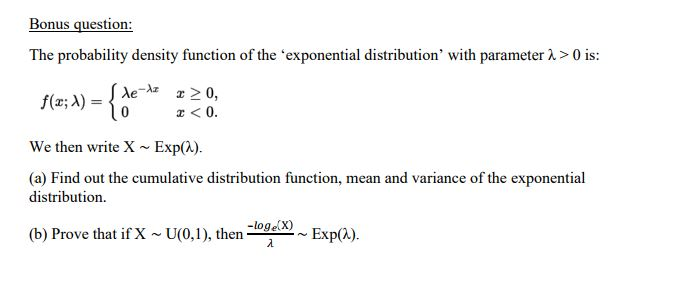
- CDF FOR EXPONENTIAL DISTRIBUTION INSTALL
- CDF FOR EXPONENTIAL DISTRIBUTION FULL
- CDF FOR EXPONENTIAL DISTRIBUTION SERIES
returns Float32Array( )īy default, the function returns a new data structure. returns Float32Array( ) // Works for plain arrays, as well. To specify a different data type, set the dtype option (see matrix for a list of acceptable data types). var data = [īy default, when provided a typed array or matrix, the output data structure is float64 in order to preserve precision. To deepset an object array, provide a key path and, optionally, a key path separator. var x = įor non-numeric arrays, provide an accessor function for accessing array values. To adjust the parameter, set the corresponding option. Default: '.'.Īn exponential distribution is a function of one parameter: lambda(rate parameter).

The function accepts the following options: var matrix = require( 'dstructs-matrix' ), x may be either a number, an array, a typed array, or a matrix. Usage var cdf = require( 'distributions-exponential-cdf' ) Įvaluates the cumulative distribution function for the exponential distribution.
CDF FOR EXPONENTIAL DISTRIBUTION INSTALL
Installation $ npm install distributions-exponential-cdfįor use in the browser, use browserify. P( X > 5 + 1 | X > 5) = P( X > 1) = \(\).Where lambda > 0 is the rate parameter. P ( X > r + t | X > r) = P ( X > t) for all r ≥ 0 and t ≥ 0įor example, if five minutes has elapsed since the last customer arrived, then the probability that more than one minute will elapse before the next customer arrives is computed by using r = 5 and t = 1 in the foregoing equation. Specifically, the memoryless property says that This is referred to as the memoryless property. With the exponential distribution, this is not the case–the additional time spent waiting for the next customer does not depend on how much time has already elapsed since the last customer. Since an unusually long amount of time has now elapsed, it would seem to be more likely for a customer to arrive within the next minute. Suppose that five minutes have elapsed since the last customer arrived. In recall that the amount of time between customers is exponentially distributed with a mean of two minutes ( X ~ Exp (0.5)). Memorylessness of the Exponential Distribution Reliability deals with the amount of time a product lasts. The exponential distribution is widely used in the field of reliability. There are more people who spend small amounts of money and fewer people who spend large amounts of money. For example, the amount of money customers spend in one trip to the supermarket follows an exponential distribution. There are fewer large values and more small values.
/median-56a8fa9f3df78cf772a26ec3.jpg)
Values for an exponential random variable occur in the following way. It can be shown, too, that the value of the change that you have in your pocket or purse approximately follows an exponential distribution. Other examples include the length, in minutes, of long distance business telephone calls, and the amount of time, in months, a car battery lasts. For example, the amount of time (beginning now) until an earthquake occurs has an exponential distribution. The exponential distribution is often concerned with the amount of time until some specific event occurs. Testing the Significance of the Correlation Coefficient Hypothesis Testing for Two Means and Two Proportions Two Population Means with Known Standard DeviationsĬomparing Two Independent Population Proportions Two Population Means with Unknown Standard Deviations Hypothesis Testing of a Single Mean and Single Proportion
CDF FOR EXPONENTIAL DISTRIBUTION FULL
Rare Events, the Sample, Decision and ConclusionĪdditional Information and Full Hypothesis Test Examples Outcomes and the Type I and Type II Errorsĭistribution Needed for Hypothesis Testing The Central Limit Theorem for Sample Means (Averages)Ī Single Population Mean using the Normal DistributionĪ Single Population Mean using the Student t Distribution Mean or Expected Value and Standard Deviationĭiscrete Distribution (Playing Card Experiment)ĭiscrete Distribution (Lucky Dice Experiment) Probability Distribution Function (PDF) for a Discrete Random Variable

Independent and Mutually Exclusive Events
CDF FOR EXPONENTIAL DISTRIBUTION SERIES
Histograms, Frequency Polygons, and Time Series Graphs Stem-and-Leaf Graphs (Stemplots), Line Graphs, and Bar Graphs Definitions of Statistics, Probability, and Key Termsĭata, Sampling, and Variation in Data and Samplingįrequency, Frequency Tables, and Levels of Measurement


 0 kommentar(er)
0 kommentar(er)
